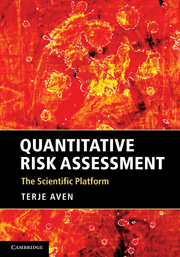Book contents
- Frontmatter
- Contents
- Preface
- Acknowledgments
- 1 Introduction to risk management and risk assessments. Challenges
- 2 Concepts and perspectives on risk
- 3 Science and scientific requirements
- 4 Introduction to case studies
- 5 Risk assessment when the objective is accurate risk estimation
- 6 Risk assessment when the objective is uncertainty descriptions
- 7 Risk management and communication issues
- 8 Towards a holistic scientific approach to risk assessment
- 9 Conclusions
- Appendix A Introduction to probability theory and statistical analysis
- Appendix B Terminology
- References
- Index
3 - Science and scientific requirements
Published online by Cambridge University Press: 05 June 2012
- Frontmatter
- Contents
- Preface
- Acknowledgments
- 1 Introduction to risk management and risk assessments. Challenges
- 2 Concepts and perspectives on risk
- 3 Science and scientific requirements
- 4 Introduction to case studies
- 5 Risk assessment when the objective is accurate risk estimation
- 6 Risk assessment when the objective is uncertainty descriptions
- 7 Risk management and communication issues
- 8 Towards a holistic scientific approach to risk assessment
- 9 Conclusions
- Appendix A Introduction to probability theory and statistical analysis
- Appendix B Terminology
- References
- Index
Summary
In this chapter we present the announced requirements of reliability and validity that will be used to verify that a risk assessment is scientific (Section 3.3). But first in Section 3.1 we give some reflections about risk assessment being a scientific method motivated by two interesting editorials of the first issue of the journal Risk Analysis (Cumming, 1981; Weinberg, 1981), in relation to the establishment of the Society of Risk Analysis. We also provide a brief review of the traditional sciences (Section 3.2), such as the natural sciences, social sciences, mathematics and probability theory, to place risk assessment into a broader scientific context. A key issue is to what extent risk assessment should be judged by reference to these traditional science paradigms, or is a science per se.
Reflections on risk assessment being a scientific method
Cumming (1981) concludes that the process of analysing or assessing risks involves science, and consequently is a scientific activity. However, according to Cumming, risk assessment is not a scientific method per se. He writes:
Risk assessment cannot demand the certainty and completeness of science. It must produce answers because decisions will be made, with or without its input. The quality of societal decisions will be influenced by the quality of the risk information which goes into them, and the long term success of a society is influenced by the quality of its decisions. Thus, risk assessment is an important activity. It depends on science and has an important stake in receiving the input of good science.
- Type
- Chapter
- Information
- Quantitative Risk AssessmentThe Scientific Platform, pp. 32 - 40Publisher: Cambridge University PressPrint publication year: 2011



